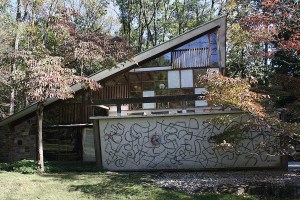20 More Local Native American Place Names and What They Mean

Background map | Shutterstock.com
Since you guys seemed to enjoy the first installment of our compendium of the meanings of Native American place names, we’re bringing you more. (Now with Jersey added!) Here’s what the Lenni Lenape who originally inhabited these parts saw in their environs.
Absecon
The city in New Jersey takes its name from the Lenape “absegami,” or “little water.” Incidentally, a Dutch captain, Cornelius Mey, who explored the area in 1614 named Atlantic County “Eyren Haven,” or “Harbor of Eggs,” for the great quantities of wildfowl eggs he found there. Mays Landing and Cape May are in turn named for him. A possible alternate (and more romantic) meaning for “absegami” is “place of swans.”
Aquetong
The Aquetong Creek in Bucks County takes its name from an Indian village, Achewetonk, whose name means “the spring among the bushes.” The “great spring” on this land was an important resource for Native Americans and European settlers; William Penn deeded the property to his friend James Logan. (See “Wingohocking,” below.)
Aronimink
Derived from “Arronemink,” the name of an Indian village at the mouth of Mill Creek; it means “where the fish cease” and may refer to waterfalls in the area.
Almonesson
One of our favorites. The Deptford County community was named for a creek whose Native American name means “young fox place.”
Cinnaminson
Hmm. Is it from “assan” and “minna,” meaning “stone island”? Or is it from “Senamensing,” meaning “sweet water”? The SweetWater Bar & Grill has its opinion on that.
Holicong
The Bucks County village is named for a natural spring, called the “Konkey Hole” by Europeans, where the Lenape once camped. The spring and the underwater river that supplied it were local landmarks. The spring, a mile east of Old York Road on Holicong Road, rises within a large funnel-shaped depression whose size varies depending on the water level. Or it did. It may be buried beneath a subdivision by now.
Juniata
Named (like Lehigh and Lycoming, below) for the county of the same name; a number of streets north of Center City are named for counties, while a number of those south of Center City are named for former governors (Mifflin, McKean, Snyder, Wolf, Ritner, Porter, and so on down to Pattison). The word comes from “onenhia,” for “stone,” and “kaniote,” “to be upright.” It thus means “standing stone people” or “people of the standing rock.”
Lehigh
It may not sound like an Indian word, but it is: a shortened form of “Lechauwekink,” the Lenape name for the river separating Lehigh and Northampton counties. It means “where there are forks.” According to one source, the Lenape called it that because the river crossed one of their trails that separated into several paths.
Lycoming
A county in north-central Pennsylvania, a college, and a street just below Hunting Park Avenue in Philadelphia; “Legaui-hanne” means “sandy stream.” Hunting Park, by the way, is just that — the great hunting grounds of the Lenape before and after the arrival of Europeans.
Manahawkin
The gateway to Long Beach Island takes its name from the Lenape for “land of good corn,” or perhaps more precisely “fertile land sloping into the water.”
Mantoloking
The Ocean County borough’s name translates as “frog ground” or “sand place.
Manasquan
A combination of “manatah,” meaning island; ‘squaw,” meaning wife; and “han,” or stream. Together? “Stream of the Island of Squaws.” Reports say the Unami or Turtle clan of the Lenape brought their families to this Ocean County river in summer to enjoy the shellfish and shallow tidal waters.
Pennsauken
You might think this has something to do with William Penn, but you would be wrong. It’s a corruption of “pindasenaken,” which means “tobacco pouch.”
Tinicum
The island township on the Delaware River was called Tinnachkonck, which means “next to water,” logically enough. Today the John Heinz National Wildlife Refuge at Tinicum is Pennsylvania’s last remaining freshwater tidal wetland.
Tioga
The name of the North Philly neighborhood adjacent to Nicetown comes from “teoga,” which means “swift current exciting admiration” (!), or possibly “tei-ohoho-gen,” meaning “place where two rivers meet.” Then again, it could be from the Iroquois “tiagoa,” or “gateway”; one source says the river in Northern Pennsylvania that bears this name was the boundary between Iroquois lands to the north and west and Lenape lands, and that the Iroquois considered anyone who didn’t enter their territory via this gateway an enemy.
Towamencin
The Montgomery County township is named after the Towamencin Creek, from the Lenape for “poplar tree.”
Venango
Another county name, from the far west of the state, and also a township. One source says this was the Indian name for French Creek and that it’s “a corruption of the Indian term Innun-guah, given the stream by the Senecas and expressive of an indecent figure carved on the bark of a tree near its banks.” A different source says the name comes from the Native American word “onenge,” meaning “otter.” Otters are cute. Let’s stick with that and leave the indecent figures out of it.
Weccacoe
The Lenape name for the area of South Philly settled by the second wave of Swedish colonists, it means “peaceful place.” While the Weccacoe Playground at 4th and Catharine in Queen Village was being renovated a few years ago, an historic 19th-century African-American cemetery, the Bethel Burial Ground, was discovered beneath it.
Wingohocking
The Wingohocking Creek once flowed from Mount Airy through Germantown and joined the Tacony Creek to form the Frankford Creek, which then flowed into the Delaware. Starting in 1879, city engineers captured the creek inside wooden pipes and made it into a sewer. It took 50 years of working section by section to remove the creek from the city’s landscape. According to Adam Levine, writing for Hidden City Philadelphia, the same process went on throughout the city — and most American cities, for that matter. The name has been identified as meaning “favorite land for planting” and also “crooked water.” There is also a legend that it was the name of a Lenape chief who “traded names” with James Logan, a mayor of Philadelphia, a justice of the state Supreme Court, and one of the founders of the precursor to the University of Pennsylvania. The trading of names is said to have been a sign of mutual respect in Native American tradition.
Wyalusing
The Wyalusing Path was a heavily traveled trail that provided Native Americans a shortcut between the two branches of the Susquehanna River in northern Pennsylvania. It’s also the name of a creek in Susquehanna County. Wyalusing Avenue in West Philly purportedly runs through land that was the home of the Indian chief Tamanend or Tammany, leader of the Lenni Lenape, to whom William Penn sent emissaries to secure good relations. “Wyalusing,” from “M’chwihilusing,” means “home of the honorable warrior.”
Follow @SandyHingston on Twitter.


